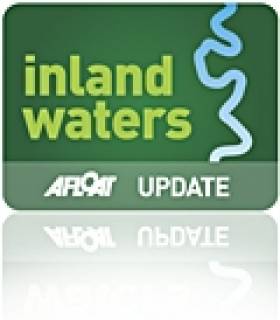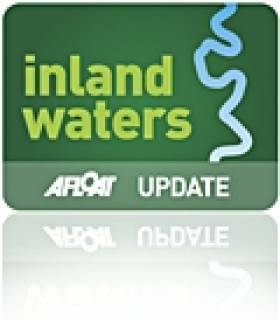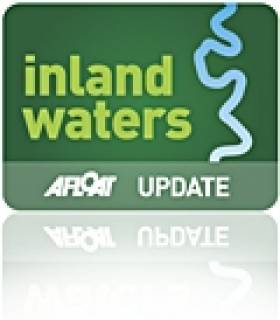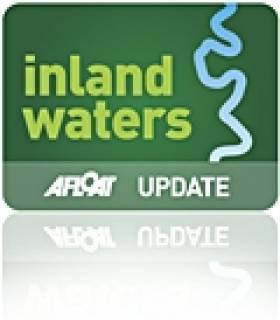Displaying items by tag: inland waters
Victorian Country Home On The Banks Of The Blackwater
#WaterfrontProperty - The Irish Examiner reports on a new arrival to the waterfront property market in Woodville House, a unique country home on the banks of the River Blackwater in Co Cork.
With an asking price of €625,000, this five-bay Victorian home between Fermoy and Mallow may be large, but owner Dr Brendan Cousins remarks on its simple maintenance.
And the four-bed main house with a self-contained two-bed annex comes with all the modern conveniences you might expect, like central heating, as well as others that might surprise, such as washbasins in the bedrooms.
But the real attraction, besides the sheltered 11-acre grounds retaining many of the old stone walls of outbuildings, is surely the salmon fishing - with local angling club members allowed access on a rotational basis.
The Irish Examiner has much more on this property HERE.
Seasonal Fishery Officers Wanted
#Jobs - Inland Fisheries Ireland (IFI) is currently seeking to recruit a number of staff as Fishery Officers nationally for periods of up to a maximum of six months duration during 2015, and will shortly commence a process to fill these positions.
The Fishery Officer will be primarily concerned with the implementation and enforcement of the provision of the Fisheries Acts, Water Pollution Acts and other relevant statutory provisions. He or she is required to:
- Provide, in co-operation with other fisheries staff, comprehensive conservation and protection services, inland and at sea, within any part of a fisheries district and/or any other area assigned within one or more fisheries districts.
- Provide, in co-operation with other fisheries staff, comprehensive improvement, and development and fisheries management support services within any part of a fisheries district and/or any other area assigned within one or more fisheries districts.
A number of positions will be concerned with assisting either directly or indirectly in fisheries-related research projects. Please note a full driving licence valid in the State is required.
Salary will be at the first point of Fishery Officer Scale (as at 1 November 2013) plus an Unsocial Hours allowance, which will be paid at either 50% or 100% relative to the number of unsocial hours worked.
Applications (a cover letter and up-to-date CV) should be sent by 12 noon on Monday 23 February 2015 to [email protected] or by post to:
HR Department, Ref: ‘HR/FO/2015’
Inland Fisheries Ireland
3044 Lake Drive
Citywest Business Campus
Dublin 24
All enquiries to [email protected] or 01 884 2662. Please note that late applications will not be processed. Canvassing will disqualify. IFI is an equal opportunities employer.
Art Of Fly-Tying Subject Of New Collaborative Art Project
#Angling - Casting Territory: A Contemporary River Keepers’ Index of Lesser Known Patterns is a new collaborative art project by artist Martina O’Brien and the Dodder Anglers Club.
O'Brien uses the art of fly-tying – where the act of imitation meets intimate knowledge – to explore the angler’s inherent awareness of flora and fauna, physical geography and role as guardians of the River Dodder with a series of alternative flies.
The exhibition is divided across three locations – RUA RED in Tallaght, the RDS Library and Archives in Ballsbridge and the Waterways Ireland Visitor Centre at Grand Canal Quay – allowing a complete story to unfold along the length and breath of the river’s axis.
In addition to this, a fly-tying demonstration will be followed by an artist-led discussion with Gareth Kennedy, Martina O’Brien and members of the Dodder Anglers core group at RUA RED from 2pm to 4pm on Saturday 7 February.
And on Saturday 21 February a collaborative discussion with Dr Karen E Till of Maynooth University, Katherine Atkinson of Create, Martina O'Brien and the Dodder anglers will take place at 10am at the RDS Library and Archives, involving a walk to the Waterways Ireland Visitor Centre (prior booking is essential).
Casting Territory is supported by an Arts Council Artist in the Community Scheme Project Realisation Award managed by Create, the national development agency for collaborative arts.
Shannon Blueway Named Ireland's Best Tourism Initiative
#InlandWaters - The Shannon Blueway has won the Best Tourism Initiative category of the 2015 Community and Council Awards presented by LAMA in association with IPB.
Waterways Ireland – which have led the development of the Shannon Blueway – attended the ceremony represented by Norma Herron, with Leitrim County Council cathoirleach Paddy O'Rourke and chief executive Frank Curran.
The Shannon Blueway is a multi-activity trail running alongside water, linking walking, cycling, canoeing, paddle-boarding, angling and cruising with local towns and villages.
Launched in October 2014, thousands of walkers, paddlers and cyclists have already enjoyed this first section of the trail from Drumshanbo to Carrick-on-Shannon, including 16.5km of canoe trail and 10km of approved walking route.
And the route is already growing, with new sections to be opened later this year on the Camlin River.
The Shannon Blueway is being delivered in partnership with the National Trails Office, Canoeing Union, Leitrim County Council and Leitrim Tourism and is being marketed under the Blueways Ireland banner on the web, Facebook and Twitter.
Waterways Ireland Schools Visit Programme For Engineers Week 2015
#InlandWaters - Waterways Ireland is hosting a series of free site visits on Ireland's navigable waterways during Engineers Week 2015 on 7-11 February.
The site visits are on offer to primary and secondary students at the following locations:
The Shannon Navigation at Tarmonbarry Lock on Monday 9 February. Tour times are 10am, 11.30am and 1.30pm. Each tour lasts for 90 minutes approx. (Offered to primary and secondary students.)
The Grand Canal at Waterways Ireland Visitors Centre, Grand Canal Quay, Dublin 2 on Monday 9 February. Tour times are 10am, 11.30am and 1.30pm. Each tour lasts for 90 minutes approx. (Tour open to primary students only.)
The Erne System at Waterways Ireland Headquarters, Enniskillen on Monday 9 February. Tour times are 10am, 11.30am and 1.30pm. Each tour lasts for 90 minutes approx. (Offered to primary and secondary students.)
The Shannon-Erne Waterway at Lock 6, Ballinamore on Thursday 12 February. Tour times are 10.30am and 1pm. Each tour lasts for 90 minutes approx. (Offered to primary and secondary students.)
Engineers Week is a programme of nationwide events with the aim of celebrating the world of engineering in Ireland. The theme for 2015 is 'Engineering is for everyone', highlighting how engineering touches the lives of every citizen. It is an ideal opportunity to highlight the range of work undertaken by the engineering staff of Waterways Ireland.
There are a range of engineering professionals including civil and mechanical engineers and technicians working within Waterways Ireland. The projects carried out on all seven navigations managed by the organisation are wide and varied, and include navigation operation, maintenance and development, structural design, project management, fleet management, development and maintenance of electro-hydraulically operated lock gates and accompanying smart card system, plus many more.
Tours are primarily aimed at senior national school students as well as secondary school students. Booking is essential and is on a first come, first served basis. Please note a maximum of 30 students can be accommodated per tour.
To register your interest in attending one of the visits offered or to find out more information regarding any of the site visits offered by Waterways Ireland, contact the Education Officer at 071 96 50787 or [email protected].
Historic 'Navigation House' To Be New Lagan Canal HQ
#InlandWaters - A dilapidated building on the Lagan Canal that once served as home for the waterway's manager will get a new lease of life as the headquarters of the Lagan Canal Trust.
As the Belfast Telegraph reports, Navigation House, built in 1866 at Lisburn's Union Locks, was sold off in the 1950s and more recently was slated for demolition.
But after a listing by then NI Environment Minister Alex Attwood in 2012, the property was acquired by the National Trust's Hearth Revolving Fund and leased to the Lagan Canal Trust, which has announced plans to once again make it the most important building on the canal.
It's hoped to host an interpretive centre in the house to educate visitors on the history of the canal and its importance to Northern Ireland.
And it may also become a focal point in opening the Lagan Navigation to the wider community through angling, canoeing, walking, cycling and other activities.
The Belfast Telegraph has more on the story HERE.
Pig Farmer Prosecuted Over Lake Pollution 'Disgrace'
#InlandWaters - "An absolute disgrace" is how a judge branded a Longford farmer convicted of polluting a local lake near Lough Ree with slurry from his pig farm.
According to The Irish Times, Donal Connaughton of Newtowncashel was found to have caused or permitted effluent to fall from up to 25 slurry tanks containing a total of four million gallons from his property in March last year.
Longford District Court heard that many of the tanks were unauthorised structures and that Connaughton had removed their roofs to comply with a previous demolition order, only making the pollution problem worse by allowing overflow to enter local water courses.
Judge Séamus Hughes jailed Connaughton for 10 weeks and fined him €3,000 with €5,400 costs. The Irish Times has more on the story HERE.
Grand Canal Towpath Closures In Dublin
#InlandWaters - The Grand Canal towpath in Dublin between the 3rd Lock in Inchicore to the 12th Lock in Lucan will be closed temporarily in various locations for different durations this spring.
The first of these closures are this week, with part of Section 3, between Park West Avenue and Ninth Lock Road, closed till this Friday 16 January, and Section 4 (Ninth Lock Road to the R120 at Adamstown) closed till Friday 30 January.
ESB Networks will be carrying out essential works on the electricity network until March 2015 on this route between the Naas Road and Grange Castle so check the South Dublin County Council website for the latest news.
Get Listed In Waterways Ireland's 2015 Events Guide
#InlandWaters - Waterways Ireland is producing a 'What's On' guide which features festivals and events occurring within an eight-mile corridor of the waterways under its remit.
Over 10,000 copies of the guide will be distributed free of charge to both local and national markets, covering events in the vicinity of the Lower Bann, the Erne system, the Shannon navigation and Shannon-Erne waterway, the Barrow navigation and Royal and Grand Canals.
If you would like to be considered for inclusion in the 2015 edition, please complete this entry form and return it to Waterways Ireland, Marketing & Communications, 2 Sligo Road, Enniskillen, Co Fermanagh BT74 7JY or fax to +44 (0)28 6634 6257 no later than 22 January 2015.
If you wish to respond via email please do so to [email protected]. Please also ensure to complete your entry for the free online events listing.
More details are available on the Waterways Ireland website HERE.
'Hugely Positive Response' To Barrow Blueway Project
#InlandWaters - Waterways Ireland says it has already received a "hugely positive response" following engagement with interested parties from local communities, activity providers, accommodation and food establishments in relation to the Barrow Blueway project.
A series of public information events have taken place in Carlow, Kilkenny, Laois and Kildare where hundreds attended and viewed the proposals, designs, route selection and surface types.
Waterways Ireland staff were also on hand to deal with any queries in relation to the design and environmental aspects of the Barrow Blueway.
Presentations to the local authorities and their elected members have also taken place in Carlow, Kildare and Laois with the presentation to Kilkenny local authority scheduled to take place in January.
There is also one additional public information event planned to take place in Rathangan, Co Kildare next month.
The cross-border body for Ireland's main inland navigations said it is happy to receive feedback on the project which, together with that received both at the public information events and local authority presentation, will be reviewed and incorporated into the project proposal where possible.
Waterways Ireland will then apply to the relevant authorities for planning approval for the Barrow Blueway project in early 2015.






































































